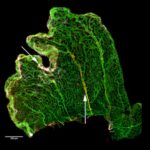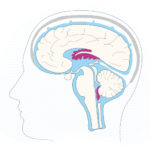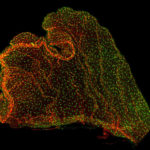Humble cells in a little-known organ manage brain inflammation
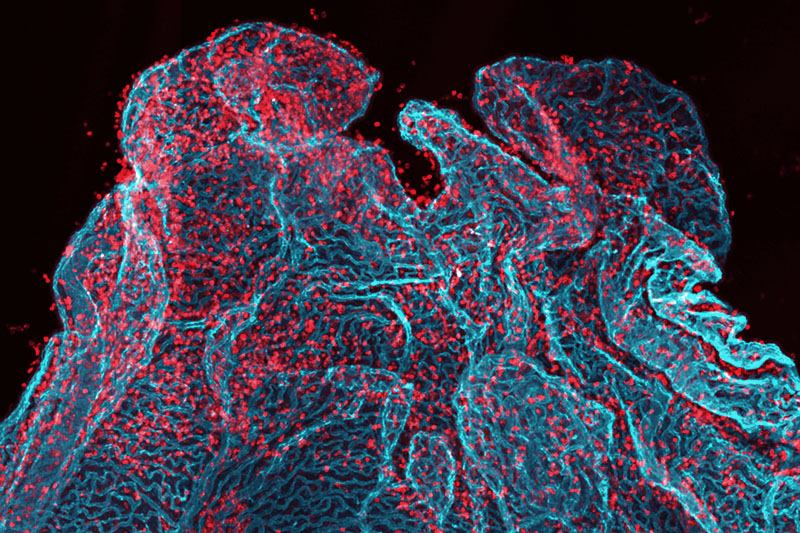
Deep in the brain, sheets of tissue known as the choroid plexus produce cerebrospinal fluid (CSF) and act as a protective barrier between the brain and CSF. But the lab of Maria Lehtinen, PhD, at Boston Children’s Hospital has shown that the little-known choroid plexus does much more. For example, it secretes factors that promote the health of the brain and CSF and influence the brain as it develops.
Now, a study led by Huixin Xu, PhD, in Lehtinen’s lab, part of the department of Pathology and affiliated with the F.M. Kirby Neurobiology Center, shows in great detail how the choroid plexus manages brain inflammation by collaborating with immune cells. The team’s observations, published in Cell, could inform future treatments for neurodegenerative and neurodevelopmental diseases that involve inflammation.
A real-time window into the choroid plexus
Xu and colleagues studied the response to inflammation in a mouse model that mimics a meningitis infection. To get a window into the brain, they carefully replaced a section of skull with a piece of clear plexiglass. Using live two-photon imaging, they could observe the choroid plexus in real time — in three dimensions — as inflammation unfolded.
Separately, they used single-cell RNA sequencing to analyze what each cell type in the CSF and choroid plexus does during the course of infection. José Ordovás-Montañés, PhD, and graduate student Peter Lotfy, both in the Division of Gastroenterology, were key contributors to this analysis.
What they saw was an intricate dance.
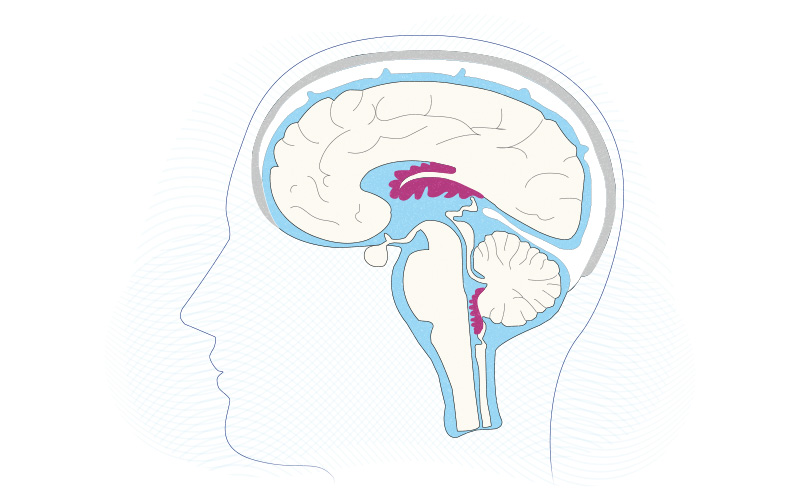
“The choroid plexus is seen as a gateway for immune cells, but not much evidence has been shown,” says Xu. “The imaging allowed us to see new immune cells from the blood entering the CSF through the choroid plexus. We also saw cells coming from the spinal fluid onto the choroid plexus — cells were trafficking in two directions.”
At the center of the action were epithelial cells in the choroid plexus, at the border with the CSF. While epithelial cells are sometimes depicted as a passive physical barrier, these cells were empowered players, coordinating the tissue’s response from start to finish.
Tracking the immune response
At the start of the mock infection, epithelial cells facilitated breakdown of the tight matrix that holds them together, creating an opening for immune cells to pass through. Neutrophils — first responders — could be seen surging across the choroid plexus barrier into the CSF.
At 48 hours, the majority of monocytes and macrophages still came through the blood, typical for a case of tissue inflammation. But another set of monocytes and macrophages was coming the opposite way — from the CSF onto the choroid plexus. The epithelial cells issued signals to recruit them, while secreting sticky adhesion molecules to help the immune cells dock and accumulate at the choroid plexus as well as growth factors that nurtured them and helped them mature.
Finally, as the infection cleared, the mature macrophages eliminated the neutrophils, helped reseal the choroid plexus barrier, and left the scene. Inflammation resolved.
“The choroid plexus is kind of like a conductor — orchestrating this symphony of a response,” says Lehtinen. “I never imagined epithelial cells would be able to organize these things. Technological advances allowed us to uncover this exciting biology that no one ever expected.”
Targeting the choroid plexus to treat disease?
Based on all of its roles, Lehtinen believes the choroid plexus qualifies as a bona fide immune organ. She and Xu are interested in exploring its role in different disease settings.
Inflammation after infection has been linked to a growing number of lifelong neurologic conditions ranging from microcephaly due to congenital Zika infections to cognitive impairments associated with long COVID. Brain inflammation is also a feature of neurodegenerative diseases like Alzheimer’s.
“This study gives us a pretty clean, contained way of showing the steps of inflammation,” says Xu. “It provides a backbone that we can then apply to see what happens in neurodegenerative and neurodevelopmental diseases.”
Lehtinen envisions treatments that would harness the choroid plexus and/or CSF to protect the brain, avoiding the neurotoxic effects of chemotherapy, for example, or protecting the brains of babies in utero from maternal inflammation.
“Epithelial cells are very secretory — could we apply this to diminish inflammation?” Lehtinen asks. “Could we step in with gene therapies? There’s a million questions.”
Learn more about research in the Lehtinen Lab.
Related Posts :
-

Exploring an unsung part of the brain: the choroid plexus
If you’ve never heard of the choroid plexus, you’re not alone. In fact, few neuroscientists know much about ...
-

An 'atlas' of the choroid plexus across the lifespan
Once viewed merely as a producer of the cerebrospinal fluid (CSF) bathing the brain and spinal cord, the choroid plexus ...
-

The tiny choroid plexus protects the prenatal brain — but may also pass on inflammation from the mother
Floating in fluid deep in the brain are small, little-understood fronds of tissue. Two new studies reveal that these miniature ...
-

Preventing 'chemo brain' with antioxidants targeting the spinal fluid
Up to three-quarters of patients receiving cancer chemotherapy suffer from “chemo brain” — a side effect that makes it harder to ...


